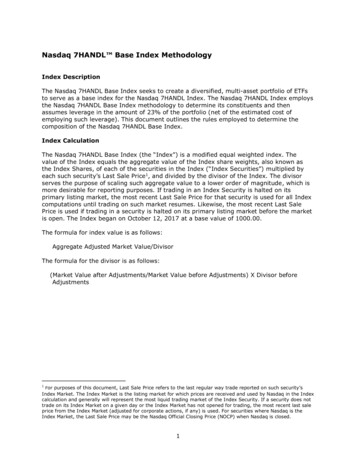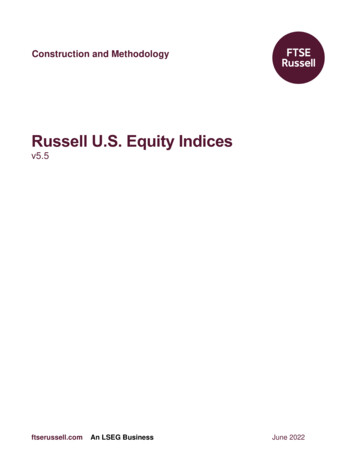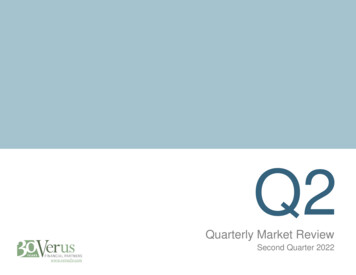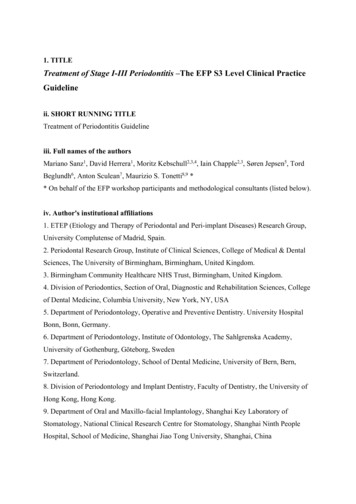
Transcription
Property IndexOverview of EuropeanResidential Markets9th edition, July 2020
Property Index 9th edition, July 2020Property Index 9th edition, July 2020IntroductionIntroduction3Highlights5Impacts of the Coronavirus Pandemicon Residential Markets in Selected Countries6Economic Development in Europe7Comparison of Residential Markets –Housing Development Intensity10Comparison of Residential Property Pricesin Selected Countries and Cities15Mortgage Markets in Europe30Annex: Comments on Residential Markets32Contacts45Authors46We are pleased to present you the ninth edition ofthe Property Index, Overview of European ResidentialMarkets. During almost a decade, Property Index hasbecome one of the most important and popular Europeanreal estate publications and has acted as a valuable source forprofessionals, institutions and general public.Property index analyses factors shaping the residential marketsand their development and compares residential propertyprices across selected European countries and cities.The publication aims to provide you with European residentialmarket data on a regular basis and to answer questions on howEuropeans live and at what costs.Despite the fact that the publication’s focus is to providea complex overview of the past year’s development onresidential markets in European countries, we could not ignorethe current unprecedented situation caused by the coronaviruspandemic. We included a brief overview of early impacts of thepandemic and related measures on residential markets in theparticipating countries and their expected future development.We hope you will find this edition of Property index interestingand that it will provide you with insights and information youneed.23
Property Index 9th edition, July 2020This year, we analyzed residential marketsin: Austria (AT); Belgium (BE); Bosnia and Herzegovina (BA); Bulgaria (BG); Croatia (HR); Czech Republic (CZ); Denmark (DK); France (FR); Germany (DE); Hungary (HU); Ireland (IE); Israel (IL); Italy (IT); Latvia (LV); Luxembourg (LU); Netherlands (NL); Norway (NO); Poland (PL);Property Index 9th edition, July 2020This edition of Property Index has thehistorically highest number of participatingcountries with Bosnia and Herzegovina,Bulgaria, Ireland, Israel, Luxembourg,Serbia and Slovakia joining the publication.Most presented indicators are on a yearon-year basis and are to some extent alsoinfluenced by geopolitical situation andvarious factors affecting the volume ofsupply and demand.A proven international and cross-functionalteam of Deloitte professionals in thedevelopment, mortgage and real estatemarkets prepared the Property Index. Thispublication has been prepared using datacollected by individual Deloitte offices inthe participating countries.Property Index capitalizes on Deloitte’sextensive knowledge of the real estateand development industry, enabling us toprovide you with independent and credibleinformation.Highlights7,145 EUR/sqmOsloLuxembourg took the position of themost expensive country in terms of newapartment prices in 2019-7.4%Average transactionprice of new dwellingsin Serbia decreasedby 7.4% between 2018and 2019, which is thebiggest fall amongcompared countries11.4For the fourth time ina row, homebuyersin the Czech Republichad pay the highestmultiple of their annualgross salary to purchasea 70 sqm dwelling Portugal (PT); Serbia (RS);Prices of new dwellingsin Norwegian capitalOslo decreased by 9.0%year-on-year12,863 EUR/sqmParis remained on the position of the most expensive city topurchase a square meter of apartment in Europe before Tel Avivand Luxembourg City Slovakia (SK); Spain (ES); and United Kingdom (UK).164%Housing prices in Lisbon andPorto were on average 164%higher than the national average,which is the highest deviationamong participating countries550 EUR/sqmWith 550 EUR/sqm of a new dwelling,Bulgaria had the lowest prices amongcountries in the Property Index30.71 EUR/sqmLuxembourg City, a new entrant into the publication,was the most expensive city in terms of monthly rent45
Property Index 9th edition, July 2020Property Index 9th edition, July 2020Impacts of theCoronavirus Pandemicon Residential Real EstateMarketsHow did residential markets in selected countries react tothe outbreak of the virus and what is expected to happenin the near future?After several years of growth across allsegments of the real estate market, year2020 was anticipated to confirm this trend.Nevertheless, since late December 2019a new type of coronavirus started to spreadacross the world from China. In Februaryand March 2020, most of the Europeancountries were hit by the pandemic andwere forced to impose restrictive measureson their economies and the free movementof citizens. Together with the rest of theeconomy, residential real estate market hasalso been affected.The economic crisis that will follow thepandemic is expected by many experts tobe the worst since the Great Depression.However, from the perspective of realestate market, this crisis is different fromthe previous one in years 2008– 2010.Negligence of banks in terms of propertyfinancing and consequent trading ofderivatives based on these loans causedthe financial crisis. The current economicdownturn have been caused by disruptionsfrom the government’s side to preventthe spread of Covid-19 disease. Banks6and developers are in a better financialcondition than on the edge of the previouscrisis.We asked our real estate experts fromparticipating countries to share theirthoughts and observations about theimmediate impacts the coronavirus hadon the residential markets and how willmarkets develop in the upcoming months.During the past crisis, we witnessed a hugeshrink in construction activity, when manydevelopers had financial problems andmost of the projects were put on hold.This resulted in record low numbers ofinitiated and completed dwellings in yearsafter the crisis, which in combination withlow financing costs and economic upturnkick-started the residential price growthacross Europe and deepened the shortageof dwellings in several countries. Ourexperts agree that in case of a long-lastingeconomic downturn, a similar pattern mayappear on some markets. Nevertheless,development companies are in a betterposition to handle complications andalthough a slight delay in permittingprocesses and construction may occur,there must not be a significant outage ofproduction in order to protect the housingmarket. The role of government help, eitherin form of guarantees or direct financialinvolvement, will be crucial to tackle thisimminence.Immediately after the implementation ofprotecting measures in the participatingcountries, residential markets in mostof them effectively froze. The majorityof pending transactions, which were inearly phases of the process, were put onhold. Almost no new deals were initiated,as personal property inspections werealmost impossible to perform. Somecountries reported a year-on-year declinein transactions by up to 80%. The effecton construction activity varied betweencountries based on the tightness ofprotective measures. For example inFrance, works on 90% of constructionsites were interrupted, while in the CzechRepublic, workers only needed to adapt toadditional hygienic rules. Another threat toconstruction works might be the shortageof labor, especially in countries, wheremost of the construction workers arefrom abroad and returned home after theoutbreak of the coronavirus.Rental markets in most of the participatingcountries demonstrated the fastestresponse to new circumstances on themarket. Especially in major cities, suchas Paris, Rome, Prague or Budapest,restrictive measures effectively stoppedthe inflow of tourists and many ofapartments located in city centers,originally used for P2P accommodationservices, were introduced to the long-termrental market, which created a pressure onrents to decrease. However, it is uncertain,whether these dwellings will return to theshort-term market once tourism activityrecovers.The development of the residential realestate market across Europe variesfrom country to country. In ten out of23 participating countries, stagnation isexpected on the residential market in termsof price and a decline in terms of transactionactivity. Experts from six countries havenegative expectations in terms of pricedevelopment and overall market activityin the future. These countries being ones,which were hit hard by the virus (the UnitedKingdom, Croatia) or ones with alreadyslowing markets (Hungary). Contrary,a positive outlook is being articulated byrepresentatives from countries, whichhave strong fundaments for furtherdevelopment of the residential market.These countries being Belgium, whereprices were growing constantly for the last37 years, the Netherlands, Norway, Israel,Slovakia and the Czech Republic. In any case,these predictions were made with currentlyavailable information on the epidemiologicand economic situation and might change incase of unexpected events.Transaction activity in Q2 2020 is expectedto be significantly lower than in the previousyears on most of the selected markets.A decline will be caused by uncertaintyin terms of economic and epidemiologicdevelopment that might encouragepotential buyers to postpone their decisionsinto safer times. Moreover, most of thebanks across the participating countrieshave already applied stricter conditions,such as lower LTV ratio or higher disposableincome of applicants, on new mortgageloan applications. On the other hand,interest rates of almost every central bank inEurope are close to zero, which means thatmortgage interest rates will remain low forthe upcoming period. This might encouragepeople with stable income to invest intoresidential real estate.In terms of price development, mostcountries expect property prices tostagnate or undergo a slight correctionin 2020 before returning to growth in2021 or 2022. Most positive outlooks arein countries with limited available landbank, which are also attractive for foreignprofessionals, such as Luxembourg,Belgium or the Netherlands. Contrary,a steep decline is expected in theUnited Kingdom after the market fullyunderstands the economic impacts ofthe pandemic and the still uncertainform of Brexit. Hungary also expectsan accelerated decline on the alreadycooling residential market. Othercountries that will be negatively affectedby the protective measures and cautiousbehavior of people will be traditionalsummer holiday destinations as Croatia,Spain or Italy, whose economies arehighly dependent on tourism. Especiallyprices of second homes in thesecountries might decrease significantly, asdemand will be weak.Curious circumstances can be observedon the real estate market in Bosnia andHerzegovina. Its future developmentis closely intertwined with economicdevelopment of Western Europe, as bigshare of buyers are from the numerousBiH diaspora living and working abroad.A similar phenomenon, although toa smaller extent, is to be seen also on othereastern European real estate markets.The current unexpected situation broughtseveral restrictions into the functioning ofthe residential real estate market. In theimmediate future, numerous technologicalsolutions could emerge and change theunwieldy processes on the market. In manycountries, virtual property inspectionsvia video calls were enabled to tackle thesocial distancing measures. The pandemicmight change the way people think abouthousing. Spread of the option to workremotely will possibly redirect part of thedemand from cities into more peripheralregions and adjust price levels acrosscountries to be more even. Furthermore,implementation of technologies such aselectronic validation of contract certificatesvia block chain may become part of thesales process together with virtual realitytours in development projects currently inconstruction.This crisis gives the whole market a newperspective on how people across Europelive and has a potential to change it.7
Property Index 9th edition, July 2020Property Index 9th edition, July 2020EconomicDevelopmentin EuropeThe only positive thing about the recessionis that inflation is not a concern. Weakdemand and low oil prices will keepinflation close to zero (maybe even innegative territory). HICP inflation reachedonly 0.1% in May.ECB reacted swiftly to the crisis. It cut thedeposit rate by 10 bps to -0.5%. Moreoverit renewed asset purchases programsand also affirmed that it would preventunjustified increases in costs of debtfinancing of Eurozone countries throughbond purchases.Fiscal policies of EU countries reacted torecession in two ways – automatically anddiscretionary. Automatic reaction meansthat government budgets run deficitswhenever economies fall into a recessionand they stabilize economies by doing so.Apart from that, governments supporteconomies by discretionary measures.Mainly employment subsidies (“Kurzarbeit”),and postponement or remission of taxpayments are used. Credit guaranteeschemes are also utilized. Aim of the abovementioned measures is to strengthen cashflow of firms and households that wassignificantly hurt by lockdown of economies.As government debts of several Europeancountries were not on a sustainablepath even before outbreak of COVID-19pandemic a renewal of sovereign debt crisiscannot be ruled out. European wide 750 bn.EUR fiscal stimulus is in preparation.Apart from COVID-19 caused recession,European Union faces other problems –trade tensions, and Brexit. Great Britain leftthe EU on 31st January. Transitional periodwill expire on 31st December 2020. In themeantime, a trade agreement must benegotiated. Therefore no-deal Brexit is stilla real possibility.Growth of Real GDP in EU 28 (%)4%The economy of Eurozone has beengrowing for 6 years since 2012–2013Eurozone Sovereign Debt Crisis. However,this economic boom has been terminatedby COVID-19 pandemic that has spreadfrom China to the entire World. Europewas one of the worst hit region, especiallycountries Italy and Spain. To combat thepandemic severe lockdown (restrictionof movement) of economies had to beimposed. The resulting economic recessionwill be even deeper than 2008–2010Financial Crisis. Services are hit to greaterextent by lockdown than manufacturingwhich is evident from developments ofpurchasing managers' indices.The economy of Eurozone is forecasted todecline by 6.3%. The downturn will be thedeepest in countries that were severely hitby the pandemic – Italy where decline by9.1% is expected and Spain with expecteddecline by 8.0%. The German economy,the biggest trading partner of the Czecheconomy, is forecasted to decline by7.0%. The Czech economy was affected intwo ways – domestic lockdown restrictsservices (mainly hospitality and catering,and tourism) and decline in economic8activity in the Eurozone restricts exportdemand for manufacturing production.As a result, we forecast the Czech GDPto drop by 10.0% this year, i.e. even morethan Italy and Spain. Preliminary dataabout GDP in Q1 2020 confirm that declineof Czech economy will be deep as Czecheconomy contracted by 3.3% in qoq termsversus contraction of EU economy by 3.5%and of Eurozone by 3.8%. We forecast therecovery to be fast but the pre-crisis levelwill be reached probably as late as in 2022provided no further lockdown is necessary.The trend of improving labour marketsituation is over. The labour marketsituation will worsen again because ofa deep recession. The unemployment ratein EU will jump to roughly 10% this yearfrom a record low of 6.3% last year. Reliefcan be expected next year provided a nextwave of the pandemic does not arrive.Closure of borders and localization ofsupply chains paralysed internationaltrade much more than trade disputes didin recent years. A deep decline of foreigntrade turnover can be expected.The resultingeconomic recessionwill be even deeperthan 2008–2010Financial 02021Source: Eurostat, Deloitte forecastThe housing market is usually sensitiveto economic conditions, especially GDPgrowth and interest rates. Correlationbetween lagged GDP growth and houseprices in the EU reached 83% during thelast 10 years. Thus, the economic downturnis likely to reduce house prices in thecoming months and years. On the otherhand, the accommodative monetary policyof the ECB and other central banks in theEU will keep interest rates at low levels thatwill be supportive for the housing market.9
Property Index 9th edition, July 2020Property Index 9th edition, July 2020Completed dwellingsThe indicator of housing developmentintensity on the residential market showsthe number of completed dwellings per1,000 citizens in a given country. Due todifferences in population of the participatingcountries, recalculating the indicator toper 1,000 citizens allows to compare thedevelopment activity between them.Five countries, Bulgaria, Bosnia andHerzegovina, Portugal, Spain and Latviahad less than two completed apartmentsper 1,000 citizens in 2019. However,Portugal, Bulgaria and Spain are among fourcountries with the highest housing stockper 1,000 citizens, so these countries mightnot need to expand it. Especially in case ofBulgaria, whose population has decreasedby over a million since year 2000.1,000 citizens. Latvia and Bulgaria followedwith 3,300 and 4,500 completed dwellingsrespectively.Contrary, the highest number of dwellingsper 1,000 citizens, over 11, had beencompleted in Luxembourg, followed byFrance with 6.7 dwellings per 1,000 citizens.In terms of absolute values, France defendedits position of European leader in dwellingcompletions with almost 450,000 dwellingsdelivered to the market in 2019. Germanyand Poland followed with 293,000 and207,500 completed apartments respectively.The lowest development intensity couldbe observed in Balkan countries, wherethe population is decreasing due to themigration of workforce into westernEuropean countries.Among central European countries,Poland retained its position as a regionalleader both in terms of completions per1,000 citizens (5.4) and total number ofcompleted dwellings (207,500).Only 2,900 dwellings were completedin Bosnia and Herzegovina in 2019,which translates into 0.9 dwellings perHousing Development IntensityIndex of number of completed dwellings per 1,000 citizens147.311.6512Comparisonof ResidentialMarkets – UUKNumber of completed dwellings per 1,000 citizensDKCZNLIEBEFRLUTotal number of completed dwellings (ths.)10Source:Deloitte national offices10118
2Property Index 9th edition, July 2020Property Index 9th edition, July 202001410Initiated dwellingsSimilarly, as in terms of completed dwellings12 1,000 citizens, Luxembourg recordedperalso the highest number of initiateddwellings per 1,000 citizens, 8.9, which madeup for 5,600 started dwellings. Poland and10France followed with 6.2 and 6.1 initiateddwellings per 1,000 citizens respectively.8 lowest new construction intensity wasTherecorded in Bulgaria, with only 0.1 initiateddwellings per 1,000 citizens in 2019, whichtranslates into less than 1,000 started6apartments across the country. Bosniaand Herzegovina and Latvia had 1.2 and1.3 initiated dwellings per 1,000 citizensin42019 and 4,000 and 2,500 starteddwellings in total respectively.Bulgaria, Bosnia and Herzegovina and2Latvia are accompanied by Luxembourg,the smallest country participating in thepublication, as countries with less than10,000 initiated dwellings.As in terms of completed dwellings, thehighest absolute number of initiateddwellings was in France (410,300), Poland(237,300) and Germany (219,500). Thesethree were the only countries with over200,000 initiated dwellings. Germanyhad lost the second position from 2018because of a 37% fall in the number ofinitiated dwellings.Double-digit decreases in newdevelopment intensity had also beenrecorded in the Netherlands (-18%), UnitedKingdom (-10%) and Belgium (-10%).Initiations also decreased in Hungary,Denmark, Slovakia and France.On the other hand, twelve countriesreported an increase in residentialconstruction activity. Initiated dwellingsgrew by 31% year-on-year in Croatia from11,500 to 15,200. Intensive accelerationcould be also seen in Portugal ( 18%),Ireland ( 17%) and the Czech Republic( 17%).As in terms of completed dwellings, Polandhad shown the highest developmentintensity among central Europeancountries, leading by over two dwellingsper 1,000 citizens before Slovakia. As thelargest country in the region, having morethan twice as many initiated dwellings asHungary, Slovakia and the Czech Republiccombined.Housing StockThe overall size of the housing stock, alongwith its quality, can be generally seen as8an indicator of quality of life and level ofeconomic development of a country.The highest stock per 1,000 citizens could6be found in Portugal and Italy with slightlyover 581 dwellings. That is almost twice asbig as housing stock in Israel, where therewere only 293 dwellings per 1,000 citizens.4Israel reported by almost 70 apartmentsless than in the United Kingdom, which hadthe second lowest number of dwellings per1,000 citizens with 361 apartments.2Another three countries, Slovakia, Poland andLuxembourg, had less than 400 dwellingsper 1,000 citizens. However, Poland andLuxembourg were also among countrieswith high development intensity, hence theirhousing stock is expected to grow.Portugal, Bulgaria and Spain were countrieswith relatively large housing stock per 1,000citizens and the development intensityin terms of both initiated and completeddwellingsfollowed by France (35.67 mil.) and Italy(35.09 mil.).Spain (25.78 mil. dwellings), theUnited Kingdom (24.35 mil.) and Poland(14.82 mil.) were also countries with morethan 10 mil. dwellings.Contrary, the smallest stock was reportedin Luxembourg with 244,000 apartments.Less than three million dwellings could bealso found in Slovakia (2.06 mil.), Ireland(2.06 mil.), Norway (2.58 mil.), Denmark(2.68) and Israel (2.68 mil.).The largest housing stock could befound in Germany, 42.54 mil. dwellings,0Housing StockNumber of dwellings per 1,000 citizens0700Housing Development IntensityIndex of number of initiated dwellings per 1,000 85.9224.35410.3 ber of initiated dwellings per 1,000 citizens700Source: Deloitte national officesDKNLHUCZHRSKBEIEILNOFRPLLUILTotal number of initiated dwellings (ths.)IENumber of dwellings per 1,000 citizensDEFRBGTotal number of dwellings (mln.)Source:Deloitte national offices1412600UK1312
Property Index 9th edition, July 2020Property Index 9th edition, July 2020Comparison of ResidentialProperty Prices in SelectedCountries and CitiesThe ninth edition of Property Index coversdata from 23 European countries and 67cities. In order to harmonise the outcomes,all price statistics are calculated in Euros.However, besides market movements,annual prices changes were alsoinfluenced by changes in exchange rates.Depreciation or appreciation of nationalcurrencies other than Euro are shown inthe chart below. The largest year-on-yeardifference have been seen in Israel, wherethe Israeli new shekel appreciated by over4% against Euro. On the other side, Euroappreciated against Norwegian kroneand Hungarian forint by 2.5% and 1.8%respectively. There were virtually no changesin the average annual exchange rates inrelations between Euro and Croatian kuna,Czech koruna and Bosnia and Herzegovinaconvertible mark.Euro Exchange Rates Changes, annual changes( %) Euro appreciation, (-%) Euro RSD-0.32%EUR/GBP-0.92%EUR/ILS-4.29%-5.0%14Source: Yahoo Finance-4.0%-3.0%-2.0%-1.0%0.0%1.0%2.0%3.0%15
Property Index 9th edition, July 2020Property Index 9th edition, July 2020Norway #4,120 EUR/ sq m1.9%Average Transaction Price of a New Dwellingin Selected Countries (EUR/sqm), 2019Despite continuous convergenceof European economies and closeinterconnections between them,the residential markets developingindependently in each country. Among23 participating countries, four recordeda price decrease and 19 showed growth inprices of new dwellings.Luxembourg, taking part in the survey forthe first time, assumed the position of themost expensive country to buy a squaremeter of a new apartment in 2019 with7,145 EUR, more than 2,500 EUR aheadof France with 4,523 EUR/sqm. Austriaand Norway recorded average pricesover 4,000 EUR, with 4,176 EUR/sqm and4,120 EUR/sqm. However, data for Norwayare only available for detached houses, asno other transactional data were available.Another three countries, Israel, the UnitedKingdom and Germany, were in the rangebetween 3,700 – 3,900 EUR/sqm.Latvia1,646 EUR/ sq m-5.4%On the other hand, two other newlyincluded countries, Bulgaria and Bosnia andHerzegovina, were countries with the lowestprices of new dwellings. Bulgaria recorded550 EUR/sqm and Bosnia and Herzegovina849 EUR/sqm of newly built apartment.Slovakia, Ireland, Croatia, Latvia, Poland,Hungary, Serbia and Portugal are countries,whose prices were in a range from1,000 EUR/sqm to 2,000 EUR/sqm. Mostof these countries are from central andeastern Europe, which might indicate thatEurope can be divided into two parts basedon dwelling prices. From this region, onlyprices in the Czech Republic were out of theabove mentioned range with 2,602 EUR/sqm,especially due to high share of Prague onthe national average.Netherlands**2,632 EUR/ sq m4.4%Germany*3,727 EUR/ sq m9.5%Ireland1600 EUR/sq m-1,2%Belgium*2,583 EUR/ sq m4.1%France4,523 EUR/ sq m12.6%Five countries, Luxembourg, France,Spain, Hungary and Slovakia had growthsexceeding 10% in ��2,0003,501–4,0002,001–2,500 4,001*bid price** older dwellings# detached houseSource: Deloitte national offices16Luxembourg7,145 EUR/ sq m12.9%Czech Republic2,602 EUR/ sq m8.6%Portugal1,162 EUR/ sq m6.3%Spain2,398 EUR/ sq m12.4%Poland1,520 EUR/ sq m9.7%Slovakia*1,770 EUR/ sq m11.0%Austria4,176 EUR/ sq m3.9%Croatia1,664 EUR/ sq m7.6%Italy2,314 EUR/ sq m0.1%Average Transaction Price of the New Dwelling (EUR/sq m), 2019Annual Change (%) 1,000Denmark3,124 EUR/ sq m3,0%United Kingdom3,861 EUR/ sq m2.3%Hungary1,475 EUR/ sq m11.5%Serbia1,249 EUR/ sq m-7.4%Bosnia andHerzegovina849 EUR/ sq m3.7%Bulgaria550 EUR/ sq m1.9%Israel3,882 EUR/ sq m4.3%17
Property Index 9th edition, July 2020Property Index 9th edition, July 2020Average Transaction Price of a New Dwelling (EUR/sqm) and annual 5,1874,5210.9%1,774Galway0.0%1,853Tel %The 4%Wroclaw10.0%9.0%11.5%5.3%79013.0%2,805Banská na5.5%Alicante-9.3%London (inner)-0.2%London 2,3787,6995,7323,2942,868Average transaction price of a new dwellingAnnual change* bid price** older dwellingsAverage TransactionPrice of a New Dwellingin Selected Cities2,107-1.8%-0.3%1,6481,081#detached houses8,250CorkTurin8.4%Source: Deloitte national offices6,960DublinRome2.4%Novi ankfurtLuxembourg 3152,7482,9546,3045,6155,0332,1151,7311,360Paris was again the most expensive cityin our publication in terms of transactionprices of new dwellings in 2019 with12,863 EUR/sqm. There was a slightdecrease by 0.4% in comparison to 2018.No other participating city had pricesover 10 000 EUR/sqm, but Tel Avivand Luxembourg City came close with9,769 EUR/sqm and 9,565 EUR/sqmrespectively.Only two more cities, Münich (8,250 EUR/sqm)and London (7,699 EUR/sqm), overcamethe 7,000 EUR/sqm threshold. Relativelylarge differences in prices in the mostexpensive cities in the publication mightindicate that these cities are the mostattractive on their home markets and inEurope as a whole and they attract peoplefrom all around the world, which pusheshousing prices higher.Among central European cities, Prague wasthe most expensive in terms of purchasinga new dwelling in 2019 with 3,395 EUR/sqm.Bratislava places second by over 500 EUR(2,805 EUR/sqm).In terms of year-on-year changes, prices inBergen in Norway grew the most between2018 and 2019, by 24.6%, followed by Portowith an increase of 20.1%. Another 15 citiesrecorded a double-digit growth last year.Niš from Serbia and Varna and Burgas fromBulgaria were the only three cities withprice levels below 1,000 EUR/sqm. A squaremeter of a new dwelling in Niš cost only790 EUR and was the cheapest among theexamined cities in 2019. Varna and Burgasrecorded 837 EUR/sqm and 863 EUR/sqmrespectively.On the other hand, prices decreasedin
on the real estate market in Bosnia and Herzegovina. Its future development is closely intertwined with economic development of Western Europe, as big share of buyers are from the numerous BiH diaspora living and working abroad. A similar phenomenon, although to a smaller extent, is to be seen also on other eastern European real estate markets.











